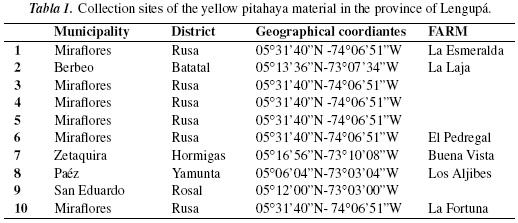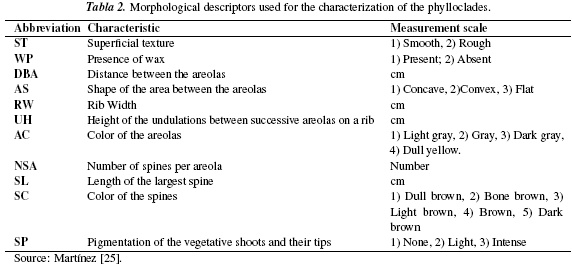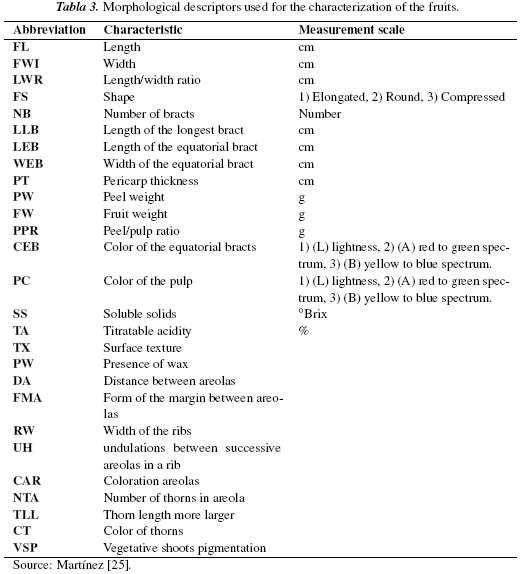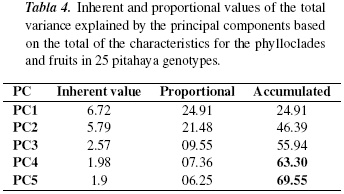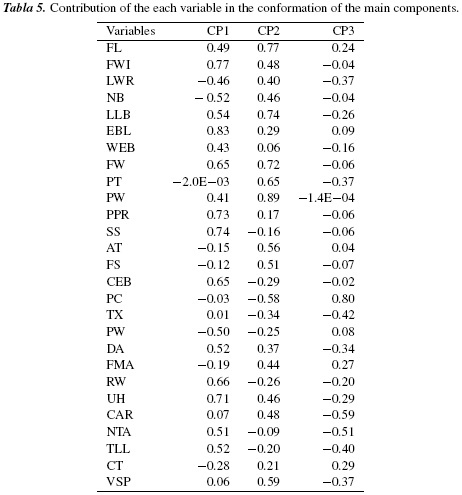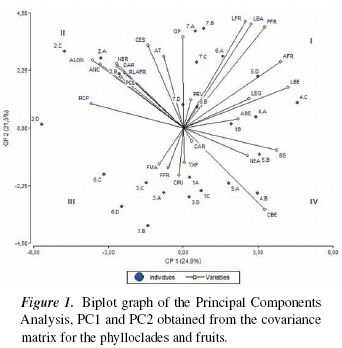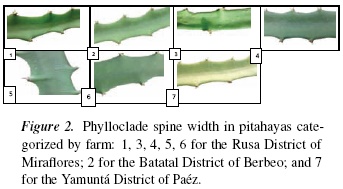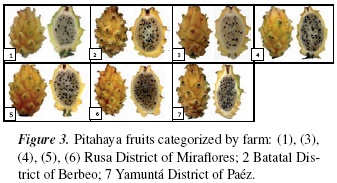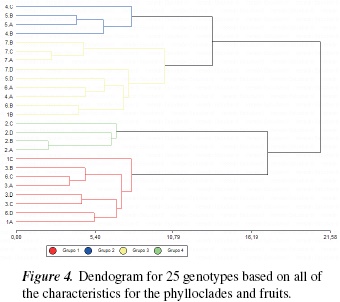Serviços Personalizados
Journal
Artigo
Indicadores
-
 Citado por SciELO
Citado por SciELO -
 Acessos
Acessos
Links relacionados
-
 Citado por Google
Citado por Google -
 Similares em
SciELO
Similares em
SciELO -
 Similares em Google
Similares em Google
Compartilhar
Ciencia en Desarrollo
versão impressa ISSN 0121-7488
Ciencia en Desarrollo vol.7 no.2 Tunja jul./dez. 2016
Morphological Characterization of Selenicereus megalanthus (K. Schum. ex Vaupel) Moran in the Province of Lengupá
Caracterización morfológica de Selenicereus megalanthus (K. Schum. ex Vaupel) Moran en la provincia de Lengupá
Ana Cruz Morilloa*
Yeily Paola Tovara
Yacenia Morillob
a Grupo Competitividad Innovación y Desarrollo Empresarial (CIDE), Facultad de Ciencias Agropecuarias, Universidad Pedagógica y Tecnológica de Colombia. Tunja, Colombia.
* Autor de correspondencia: ana.morillo@uptc.edu.co
b Grupo de Investigación y Proyección en Producción Agropecuaria (GIPPA), Universidad de Caldas. Manizales, Colombia
Recepción: 13-dic-2015 Aceptación: 28-abr-2016
Abstract
The yellow pitahaya Selenicereus megalanthus (K. Schum. ex Vaupel) Moran is an exotic fruit with an interesting market potential both domestically and internationally. The aim of this study was to identify the genetic variability that exists in the municipalities that produce it in the province of Lengupá with a morphological characterization of 25 genetic materials using 27 descriptors, of which 18 were quantitative and 9 were qualitative, for the phylloclades and fruits. The principal component analysis determined that the main morphological characters discriminant of variability are: rib width (RW), height of the undulations between successive areolas in a rib (UH), fruit length (FL), fruit width (FWI), length of the longest apex bract (LAB), equatorial bract length (LEB), fruit weight (FW), peel weight (PW), pulp/peel ratio (PPR), soluble solids (SS), fruit shape (FS). The heirarchical cluster analysis resulted in four groups that corresponded to where the materials were collected. Genetic diversity exists in the yellow pitahaya which must be used in the breeding programs.
Key words: Cactaceae, Diversity, Descriptors, Phylloclades.
Resumen
La pitahaya amarilla, Selenicereus megalanthus (K. Schum. ex Vaupel) Moran, es un frutal exótico, con un interesante potencial de mercado tanto a nivel nacional como internacional. El objetivo de este trabajo fue identificar la variabilidad genética existente en los municipios productores de la provincia de Lengupá, para lo cual se realizó la caracterización morfológica en 25 materiales genéticos, usando 27 descriptores de los cuales 18 eran caracteres cuantitativos y 9 cualitativos para filocladodios y frutos. El análisis de componentes principales determinó que los principales caracteres morfológicos discriminantes de variabilidad son: ancho de las costillas (ANC), altura de las ondulaciones entre aréolas sucesivas en una costilla (ALON), largo de fruto (LFR), ancho del fruto (AFR9, longitud de la bráctea más larga del ápice (LBA), longitud de brácteas ecuatoriales (LBE), peso del fruto (PFR), peso de la cáscara (PCA), relación cáscara/pulpa RCP, sólidos solubles SS, forma del fruto (FFR). El análisis de conglomerados jerárquicos permitió la formación de cuatro grupos de acuerdo con el sitio donde fueron colectados los materiales genéticos. Existe diversidad genética en la pitahaya amarilla la cual debe ser utilizada en programas de mejoramiento genético.
Palabras clave: cactaceae, diversidad, descriptores, filocladodios.
1. Introduction
The species of the genera Hylocereus, Selenicereus, Cereus, Leptocereus, Escontria, Mytilloactus, Stenocereus and Opuntia are known as pitahaya, dragon fruit, and the flower cup, among others, and belong to the Cactaceae family; approximately 35 of these species have the potential for cultivation, for the production of fruits, vegetables, or roughage [1]. The Selenicereus megalanthus (K. Schum. ex Vaupel) Moran species, known as yellow pitahaya due to the color of the exocarp, is considered a semiwild cactus; with 20 species [2], it is distributed in Bolivia, Peru, Ecuador, Colombia and Venezuela, with broad adaptation; it is found in warm, humid regions at sea level to high altitude, cold zones. Although this species best develops in sub-humid climates, it is adapted to dry climates, but is susceptible to low temperatures [3].
The yellow pitahaya (S. megalanthus) has evolved in the semi-humid forests of Colombia, between 1,180 and 1,932 m.a.s.l., at temperatures of 18 to 24°C and annual precipitation of 1,300 to 2,200 mm; it is characterized as a crop for steep terrains, where it is a monocrop or a crop associated with plantain, banana and coffee, which provide shading [3]. It is a perennial, climbing, epiphyte plant that is commonly found growing on trees or rocks, to which it adheres with adventitious roots that grow out of phylloclades with three ribs. The flowers are large (approximately 25 cm), hermaphroditic, symmetrical, and complete, with inferior ovaries, numerous stamen and petals and a nocturnal habit. The fruits are intense yellow berries with a sweet, succulent, white pulp, an oval to oblong shape, and high carbohydrate content (10-16%). The soluble solids oscillate between 11,9 and 17,2 °Brix, the titratable acidity is constant and the pH is reduced, which is why it is classified as moderately acidic. The fruits contain numerous seeds (40 to 800 per fruit) that are black, shiny, oblong, and smooth [4-5]. Propagation occurs through the phylloclades or seed dispersal by animals; in commercial crops, sexual reproduction is not used because plantlets require between 4 and 6 years reaching the reproductive stage [6].
In Colombia, knowledge of this crop mainly comes from the empirical processes of farmers who are motivated by the prices that the fruits can fetch in some of the months of the year; however, the increasing penetration into the international market requires research on the processes of propagation, on obtaining elite material, and on resistance to biotic and abiotic factors, among other topics [5]. However, one of the bigger limitations is the broad morphological variation seen in the vegetative structures, which leads to confusion in the recognition of each species with a lack of consensus [7], with classification mainly based on the number of areola ribs, the contour of the stem, the relative firmness of the stem [8] and the size and color of the fruits; in addition, various studies on domesticated cactus species have demonstrated variations in fruit characteristics related to the domestication process, resulting in a lack of a taxonomic database [9-13]. In Colombia, taxonomic studies have established differences, defined some varieties [14-15], and demonstrated the existence of numerous pitahaya species, wild and domesticated, with notable species that have yellow fruits with a white pulp, red fruits with a white pulp, and red fruits with a red pulp.
Therefore, there is a need for a detailed classification and characterization of the genetic diversity due to the fact that the permanence of this species in natural conditions depends on the variability and population distribution; this knowledge is essential because environmental conditions put genetic resources at risk [16], especially for some pitahaya materials be-cause the management is traditional and this species is found in gardens and family plots where the selection and propagation of individuals with desirable morphological characteristics are favored, which is introduced little by little to commercial crops. Morphological characteristics have been used as diversity indicators and to reflect the genome and its biological and environmental regulation, thereby creating the primary natural perception, and are distinguishable through direct observation (phenotype) [16]. Studies based on morphological data and standardized measurements are important for the general description of all of the species although, on occasion, there are variations due to the environment. Other descriptors are more stable and can be used to measure the divergence between species. In plant populations with divergent morphological patterns, an analysis of the relationship of the characteristics facilitates an understanding of the population variations and the genetic identification of similar groups; therefore, the morphological characterization is the first step in the planning of strategies of crop conservation and breeding [17].
At the international level, there have been studies on the morphological characterization of different species of commercial interest that belong to the Hylocereus genus, including the Conservation and Sustainable Use of Genetic Resources of Hylocereus project carried out by the Colegio de Posgraduados in 1994, which included research related to collection, characterization, evaluation, conservation, and breeding (hybridization and selection) and discovered elite genotypes [18]. Other studies on different pitahaya species, wild and cultivated, have demonstrated that there are morphological characteristics associated with the phylloclades, flowers, and fruits that can differentiate and separate the genotypes [10, 19-26]). Mejía et al. [27], conducted an in situ morphological characterization of Hylocereus genotypes in Antioquia and Córdoba, Colombia, that established the variability of these materials in phenotypical terms, but research on the yellow pitahaya is scarce. In Colombia, there has been a physiological and morpho-anatomical characterization of the sexual seed, a standardization of the protocol for in vitro regeneration, a partial characterization of a potexvirus isolated from yellow pitahaya affected by the mosaic virus, an analysis of phytoparasitic nematodes, and an in vitro fungistatic evaluation of lactic acid bacteria against Fusarium species that cause stem rot, among others [5-6, 28-30]. One of the more complete studies was conducted by Caetano et al. [3], who, with a multidisciplinary approach, carried out the morphological, cytogenetic, physicochemical, nutritional, molecular and photochemical characterization of a germplasm bank for the yellow pitahaya at the Universidad Nacional de Colombia, Palmira, in order to improve the pitahaya crop technology found in the Valle del Cauca.
In this context, the present study aimed to morphologically characterize yellow pitahaya genetic material (Selenicereus megalanthus) from the province of Lengupá as a first step toward the identification of elite material and thereby contribute to the betterment of this crop and, especially, of the producers in this region.
2. Methodology
2.1. Collection and establishment of vegetative material in a field
The yellow pitahaya genotypes (S. megalanthus) were collected from the producing municipalities in the department of Boyacá: Berbeo, Zetaquira, Páez, San Eduardo and Miraflores, from farms where the vegetative seeds were selected (Table 1). In total, 25 genotypes were collected, with each producer contributing vegetative material (phylloclades) from their farms, which were mature, physiologically guaranteeing the development of a normal plant. The collected material was established on a farm in the Rusa District in the municipality of Miraflores, located in the Valle de Lengupá region at an altitude of 1,432 m.a.s.l. and 5°11' latitude and 73°08' longitude with an average precipitation of 2,500 mm and a temperature that oscillated between 18 and 24°C and an average relative humidity of 87%. The experimental plot was 1 ha, for each genetic material had four plants with 5 m spacing between rows and 4 m into plants.
2.2. Morphological Characterization
For the morphological characterization, 23 quantitative and 15 qualitative descriptors were used for the phylloclades and fruits [31]. In total, 11 characteristics were recorded in the characterization of the phylloclades, five quantitative ones and six qualitative ones (Table 2).
Four fruits were taken from each farm for the morphological characterization, which had the same maturation stage, that is to say the entire fruit had taken on the intense yellow color that is characteristic of the Selenicereus megalanthus species and the descriptors seen in Table 3 were measured.
2.3. Statistical analysis
The analysis was conducted with the phylloclades and fruits together in order to have a more precise idea of the differentiating power of the characteristics. With the data obtained in the field, a matrix was made using Excel that was used to carry out the Multivariate Analysis with InfoStat, version 2015; for the standardization of the data, this program subtracted the mean of the variable from each observed value and divided the result with the standard deviation of the variable, thereby scaling each value with the variance [31]. Bartlett tests were made to ensure homogeneity and subsequently descriptors generated a correlation matrix: the results were subsequently graphed onto a two dimensional plane in order to observe the grouping of the accessions with each of the descriptors. Finally, a Cluster Analysis was conducted using the WARD algorithm to create dendrograms.
3. Results and Discussion
The principal components analysis based on the correlation matrix for the 27 morphological characteristics (18 quantitative and 9 qualitative) demonstrated that the first five principal components (PC) explained 69.5 % of the total variation observed in the characterized genotypes (Table 4).
Taking into account the inherent vectors, it was observed that, for principal component 1 (PC1), the characteristics the contributed more to the variability were: equatorial bract length (EBL), fruit width (FWI), soluble solids (SS), peel/pulp ratio (PPR) and height of the undulations between successive areolas in a rib (UH); for PC2, they were: peel weight (PW), fruit length (FL), length of the longest apex bract (LAB), fruit weight (FW); for principal component three, it was: color of the pulp (PC). In general it was observed that the characteristics of the fruit are what determine the variability since they are the most discriminating among the evaluated genetic materials, obtaining values between 70 to 89%, demonstrating that these characteristics differentiated the yellow pitahaya genotypes (Selenicereus megalanthus) during the evaluation time. In the table five the contribution of each variable to the composition of the main components.
Fruit characteristics such as length, weight (77%), soluble solids content (74%) and fruit weight are characters that determine the appearance, flavor and nutraceutical properties of materials pitahaya and its potential in industry and fresh consumption use. The Biplot graph of principal components one and two, separated the individuals into four groups according to characteristics related to each of the aforementioned characteristics (Figure 1).
Similar results have been found for the characteristics associated with the phylloclades in studies on the morphological characterization of Hylocereus species as reported by [16, 19-21] and Martínez [25], who concluded that the more important characteristics for phylloclades are: texture, wax presence, distance between areolas, height of undulations between successive areolas, number of spines per areola, color of the spines and pigmentation of the shoots. Potrero [22], stated that the number of spines per areola is equal in importance to the height of the undulations because they allow for the differentiation of genotypes [32, 21]; however, Cruz [23], observed statistical differences in stem variables with wax presence being one of the more important ones. In the present study, one variable which also con-tributes contributed to the differentiation of the materials was rib width (RW, 66%) (Figure 2). Ramírez [19], Maldonado [20] Juárez [33], considered the length and number of spines to be constant variables in Hylocereus and, therefore, reliable for the description of pitahaya genotypes. In this study it was found that there was greater variation in the length of the thorns (52%) that in color (28%), which can be explained by evolution and domestication processes are subject to these materials into the environment assessed. And also, Juárez [33], reported a tendency for the reduction of the number of spines and the length of stems in H. purpusii when developed in low temperature conditions; Cruz [23], reported that the length, the podarium height and the sinuosity index were influenced by the environment because they presented lower values with high amounts of sunlight and low temperatures.
On the other hand, the distance between areolas (DA, 52%), a characteristic of principal component 1, was highly variable in all of the genotypes, a result that agrees with that obtained by Caetano et al. [3], for yellow pitahaya (S. megalanthus), with a distance between areolas that varied from 3,78 to 6,70 cm; in the present study, the distances were between 3,4 and 7,7 cm and this characteristic differentiated the materials. The height of the undulations between adjacent areolas (UH, 71%) also had one of the higher values in principal component 1 (PC1), but was not found in the groups that had high correlation with the width of the ribs (RW, 66%), which was more significant for the description of this study. The height and area of the undulations allowed Grimaldo et al. [21], to separate genotypes. However, Ramírez [19], observed wild genotypes with concave sinuosity or flat borders that changed to convex sinuosity when the plants were cultivated in a colder, drier climate. Therefore, it would be useful to contrast the influence of the environments on the undulation characteristic.
When evaluating the yellow pitahaya materials in this study, the characteristics associated with the fruits presented variation (Figure 3), results that agree with those found in other pitahaya species by Ramírez [19], Mardonado [20], Grimaldo et al. [21], Potrero [22] and Cruz [10], who found that the more relevant characteristics for fruits included: length, width, length/width ratio, peel color, peel weight, number of bracts, bract length and width, fruit weight, pulp color, and Brix degrees, which contributed significantly to the separation of the groups. Ramírez [19] and Juárez [33], indicated that, in fruits from different clones, there were variations in characteristics such as length, diameter, roundness index, pulp color, and soluble solids content, demonstrating that characteristics such as weight, peel color, number of scales and scale color are also useful for distinguishing genotypes.
Martínez [25], in a characterization of Hylocereus materials in Mexico, found that the fruit characteristics explained 77% of the total variation (74% in this study) between the characterized genotypes, with 12 important characteristics: length and width of the fruits, number of bracts, length of the apex bract, length and width of the equatorial bracts, weight and color of the peels, fruit weight, soluble solids, length/width ratio, and pulp color.
In Colombia, studies on the morphological characterization of Selenicereus megalanthus have only been reported by Caetano et al. [3], who conducted a morphological evaluation of a yellow pitahaya germplasm bank (S. megalanthus) located at the Universidad Nacional de Colombia, Palmira, using 44 morphological descriptors (34 quantitative and 10 qualitative ones, 13 for the vegetative part, 16 for the flowers, and 15 for the fruits and seeds) and found a homogenous structure; however, they recorded three characteristics with high variability: the angles that form the ribs, making a transversal cut on the cladode, the size of the aculeuses and the width of the aculeus base. In the fruits and seeds, the variables with high correlation included the weight of the fruits with the diameter, the fruit weight and diameter with the pulp and juice weight, epicarp weight and number of seeds. There were also correlations between the seed weight and the seed width and length and between the fruit aculeus size and the fruit weight and diameter. The variables that contributed more to the interspecific separation of the yellow pitahaya and that explained 74.62% of the total variability of the studied accessions in the principal components included fruit weight, fruit diameter, epicarp weight, and juice and pulp weight. The number of seeds and the size of the aculeuses had a significant weight. This study indicated the importance of characteristics associated with the phylloclades, flowers, fruits, and seeds for the identification of pitahaya materials.
The Hierarchical Cluster Analysis (HCA) based on a Euclidean distance of 10.1 formed four groups in accordance with the evaluated morphological characteristics (Figure 4).
The grouping based on all of the pitahaya genotype information agreed with the classification proposed by Franco and Hidalgo [34], who confirmed that accessions or local variables that come from a particular region are classified in defined ranges or class series as a function of the phenotypic expression of the morphological characteristics. Generally, the groupings corresponded to the geographical location where the materials were collected, with first group containing eight materials from the municipality of Miraflores, where each reference number indicates the farm, second group contained all of the material from Berbeo, third group had a lax distribution of individuals from Miraflores and Zetaquira, indicating a flow of material that could exist due to the exchange of vegetative seeds between farmers in the region and the geographical closeness of the zones, and, finally, fourth group had materials from Miraflores from different farms.
According to Franco and Hidalgo [34], who confirmed that the sum of all of the individuals with their respective variants is known as genetic variability, in the present study, thanks to the morphological characteristics of the different pitahaya materials, all of the characteristics that presented variation between the plants were able to be grouped, which corresponded with the field observations where the farmers mainly attribute differences in production to tolerances to pests and diseases, but it was difficult to differentiate the plants based on appearance and also for environmental conditions like demonstrated other studies in the Department in potatoes and grass [35].
The groupings probably adhered to the observations of Franco and Hidalgo [34], who explained that a population of individuals from the same plant species is found in a continuous interaction dynamic of adaptation to factors in which the population is growing (biotics and abiotics) and that the result of the adaptive interaction translates into an accumulation of genetic information that is stored in the members of the population, with variants of each species. Considering this and the different conditions of the habitats of the pitahaya materials collected in the Valle de Lengupá, it can be said that, although a population of individuals in a species share common characteristics and produce crosses, there were individual variants, which was seen in the molecular study carried out on these materials (data not published).
In a cluster analysis for yellow pitahaya materials evaluated by Caetano et al. [3], four groups were formed: the first group contained farms from Boyacá, Huila and Valle del Cauca, the second group had farms from Boyacá and Valle del Cauca, the third group contained farms from Boyacá and Santander, and the last group had a farm from Valle del Cauca. In general, low genetic variability was observed and it was not possible to separate the materials by geographical location because they all maintained the same genetic variability. The obtained results demonstrated a higher variation than that reported by Caetano et al. [3], but a lower variation than that found in other pitahaya species.
Therefore it is necessary to increase the genetic variability of the collection through the introduction of other materials from other production zones in this country and intra-or interspecific hybrids or the induction of mutations, among other methods. However, the existing variability must be exploited in order to create strategies for finding solutions for the principal limitations of the crop and to meet the needs of farmers, producers and consumers [2-3, 5, 32, 36].
4. Conclusions
The phylloclade and fruit characteristics significantly contributed to the division of the groups. The Principal Components Analysis allowed for the determination of the principal characteristics that explained the variation observed in the characterized pitahaya materials: rib width (RW), height of the undulations between successive areolas (UH), fruit length (FL), fruit width (FWI), length of the longest apex bract (LAB), length of the equatorial bracts (LEB), fruit weight (FW), peel weight (PW), pulp/peel ratio (PPR), soluble solids (SS), and fruit shape (FS).
The cluster analysis formed four groups that were related to the geographical location where the materials were collected, evidencing genetic flow, which influenced the genetic diversity of these populations and was higher than that reported in other yellow pitahaya studies in this country; however, it is necessary to create alturnatives to increase this genetic diversity and use it efficiently in consevation and breeding programs.
Aknowledgements
The authors wish to thank the Asociaciones de Productores de Pitahaya de Miraflores, Pitafcol y Piedras Verdes, the CREPIB, the Grupo de Investigación Competitividad, Innovación y Desarrollo Empresarial (CIDE) and the Dirección General de Investigaciones (DIN) of the Universidad Pedagógica y Tecnológica de Colombia (UPTC).
References
[1] Y. Mizrahi, J. Mouyal, A. Nerd, Y. Sitrit, "Metaxebia in the vine cacti Hylocereus polyrhizus and Selenicereus spp.", Annals of Botany, vol. 93, no. 4, pp. 469-472, 2004. [ Links ]
[2] N. Tel-Zur, S. D. Bar-Zvi, Y. Mizrahi, "Clone identification and genetic relationship among vine cacti from the genera Hylocereus and Selenicereus based on RAPD analysis", Scientia Horticulturae, vol. 100, no. 1-4, pp. 279-289, 2004. [ Links ]
[3] C. Caetano, F. Otálvaro, J. Muñoz, J. Morales, R. Suárez, C. Sandoval, M. Martínez, D. Cañar, R. Peña, E. Parra, E. Galíndez, R. Rojas, J. Jiménez, A. Benavides, L. Pérez, "Enfoque multidisciplinario para solución en el agro colombiano: El caso Pitahaya amarilla Selenicereus megalanthus", Revista Asociación Colombiana de Ciencias, vol. 23, no. 3, pp. 52-64, 2011. [ Links ]
[4] C. Padrón, "Innovaciones en el desarrollo de las cactáceas", Revista Venezolana de Ciencia y Tecnología de Alimentos, vol.3, no. 1, pp. 1-42, 2012. [ Links ]
[5] C. Caetano, J. Zambrano, E. Gómez, R. Suárez, C. Sandoval, J. Jiménez, E. Parra, "Cartilla Frutales: Pitahaya Amarilla", primera edición, Universidad Nacional de Colombia, Palmira, 2013. [ Links ]
[6] R. Suárez, C. Caetano, H. Ramírez, J. Morales, "Caracterización morfoanatómica y fisiológica de semilla sexual de pitahaya amarilla Selenicereus megalanthus (Haw.) Brtitt & Rose, Revista de la Asociación Colombiana de Ciencias Biológicas, vol. 24, no. 3, pp. 97-111, 2012. [ Links ]
[7] O. Grimaldo, A. García, J. Ortiz, L. Ruíz, "Karyotype characteristics in six genotypes of pitahaya (Hylocereus spp.). Revista Chapingo, Serie Horticultura, vol. 7, no. 2, pp.177-186, 200, 2007. [ Links ]
[8] H. Cálix de Dios, "A new subspecies of Hylocereus undatus (Cactaceae) from Southeastern México, Haseltonia, vol. 11, pp. 11-17, 2005. [ Links ]
[9] Y. Mizrahi, A. Nerd, P. Nobel, "Cacti as crops", Horticultural Review, vol. 18, pp. 291-320, 1997. [ Links ]
[10] R. Castillo, M. Livera, Márquez G, "Caracterización morfológica y compatibilidad sexual de cinco genotipos de pitahaya (Hylocereus undatus), Agrociencia, vol. 39, no. 2, pp.183-194, 2005. [ Links ]
[11] E. Arellano, A. Casas, "Morphological variation and domestication of Escontria chiotilla (Cactaceae) under silvicultural management in the Tehuacán Valley, Central Mexico", Genetic Resources and Crop Evolution, vol. 50, no. 4 pp. 439-453, 2003. [ Links ]
[12] A. Otero, A. Casas, C. Bartola, E. Pérez, A. Valiente, "Evolution of Polaskia chichipe (Cactaceae) under domestication in the Tehuacan Valley, central Mexico: reproductive biology", American Journal of Botany, vol. 90, no. 4, pp. 593-602, 2003. [ Links ]
[13] A. Carmona, Casas, " Management, phenotypic patterns and domestication of Polaskia chichipe (Cactaceae) in the Tehuacán Valley, Central Mexico", Journal of Arid Environments, vol. 60, no. 3, pp. 115-132, 2005. [ Links ]
[14] P. Sandoval, "El cultivo de la pitaya como una alternativa para el desarrollo del sector agrícola en Colombia", Federación Nacional de Cafeteros, Bogotá, Colombia, 1990. [ Links ]
[15] Corporación Colombia Internacional - CCI, "Exótica," Boletín 2 (5, 6, 11), Bogotá, Colombia, 1998. [ Links ]
[16] F. Parra, A. Casas, J. Peñaloza, A. Cortés, V. Rocha, A. González, "Evolution under domestication: ongoing artificial selection and divergence of wild and managed Stenocereus pruinosus (Cactaceae) populations in the Tehuacán Valley, México", Annals of Botany, vol. 106, no.3, pp. 483-496, 2010. [ Links ]
[17] A. Villareal, "Caracterización morfológica de recursos fiogenéticos", Revista Bio Ciencias, vol. 2, no. 3, pp. 34-46, 2013. [ Links ]
[18] M. Livera. Y. Ortiz, R. Castillo, F. Castillo, R. Martínez, J. Ramírez, A. Valencia, J. Carrillo, "Pitahaya (Hylocereus spp.): problemas, logros y perspectivas. En: La investigación al servicio del campo mexicano. S. Cruz, A. Muratalla, A. Kato. (Comps). Postgrado en Recursos Genéticos y Productividad-Genética. Colegio de Posgradados. Montecillo, Texcoco Edo. De México, pp. 69-71. [ Links ]
[19] M. Ramírez, "Caracterización y compatibilidad en pitahaya Hylocereus spp. Tesis de Maestría en Ciencias, Universidad Autónoma Chapingo, Departamento de Fitotecnia. Chapingo, Texcoco Edo. De México, pp. 108, 1999. [ Links ]
[20] P. Maldonado, "Caracterización y clasificación fenotípica de pitahaya blanca (Hylocereus undatus (Haworth) Britton y Rose) del Estado de Yucatán. Tesis profesional. Universidad Autónoma Chapingo, Centro Regional Universitario Península de Yucatán, Mérida, Yucatán, México, pp. 119, 2000. [ Links ]
[21] O. Grimaldo, A. García, J. Ortiz, L. Ruiz, "Características cariotípicas de seis genotipos de pitahaya (Hylocereus spp.), Revista Chapingo Serie Horticultura, vol. 7, no. 2, pp. 177-195. 2001. [ Links ]
[22] A. Potrero, "Caracterización morfológica y re-productiva de clones de pitahaya (Hylocereus spp.). Tesis de Maestría en Ciencias. PRGP- Fisiología Vegetal. Colegio de Posgraduados. Montecillo, Texcoco Edo. De México, pp. 122, 2003. [ Links ]
[23] I. Cruz, "La pitahaya roja (Hylocereus ocamponis) en el estado de Michoacán. Tesis de Licenciatura. Universidad Autónoma Chapingo. Departamento de Fitotecnia. Chapingo, Texcoco Edo. De México, pp. 66, 2008. [ Links ]
[24] M. García, T. Terrazas, S. Arias, "Anatomía caulinar de tres especies del género Hylocereus (Berger) Britton y Rose (Cactaceae) en México, Revista. Fitotecnia Mexicana, vol. 32, no. 3, pp. 201-208, 2009. [ Links ]
[25] G. Martínez, "Caracterización morfológica de genotipos de pitahaya (Hylocereus spp.). Tesis de Maestría en Ciencias. Universidad Autónoma Chapingo, Departamento de Fitotecnia. Chapingo, Texcoco Edo. De México, pp. 73, 2013. [ Links ]
[26] B. Solís, "Polinización y amarre de fruto de pitahaya solferina (Hylocereus sp.) en la mixteca poblana. Tesis de Maestría, Tesis de Maestría en Ciencias. Universidad Autónoma Chapingo, Departamento de Fitotecnia. Chapingo, Texcoco Edo. De México, pp. 169, 2014. [ Links ]
[27] H. Mejía, S. Muriel, C. Montoya, C. Sequeda, "In situ morphological characterization of Hylocereus spp. (Fam.: Cactaceae) Genotypes from Antioquia and Córdoba (Colombia), Revista Facultad Nacional de Agronomía Medellín, vol. 66, no 1, pp. 6845-6854, 2013. [ Links ]
[28] D. Caetano, R. Escobar, C. Caetano, J. Vaca, "Estandarización de un protocolo de regeneración en pitahaya amarilla (Selenicereus megalanthus (K. Schum. ex Vaupel) Moran)", Acta Agronómica, vol. 63, no. 1, pp. 31-41, 2014. [ Links ]
[29] O. Guzmán, L. Pérez, A. Patiño, Reconocimiento de nematodos fitoparásitos en pitahaya amarilla (Selenicereus megalanthus Haw)", Boletín Científico Centro de Museos de Historia Natural, vol. 16, no. 2, pp. 146-161, 2012. [ Links ]
[30] L. Valencia, "Evaluación de la actividad fungistática in vitro de bacterias ácido lácticas contra especies de Fusarium causantes de pudrición basal en pitahaya amarilla (Selenicereus megalanthus Haw)", Tesis de Maestría en Ciencias Biológicas, Universidad Nacional de Colombia, sede Palmira, pp. 125, 2015. [ Links ]
[31] J. Di Rienzo, F. Casanoves, M. Balzarini, L. González, M. Tablada, C. Robledo. Grupo InfoStat, FCA, Universidad Nacional de Córdoba, Argentina, 2015. [ Links ]
[32] J. Moreno, Y. Tovar, "Caracterización morfológica de materiales de pitahaya (Selenicereus megalanthus Haw) en la provincia de Lengupá, departamento de Boyacá, Tesis de grado, Universidad Pedagógica y Tecnológica de Colombia, Tunja, pp. 83. [ Links ]
[33] S. Juárez, "Caracterización de la pitahaya de Jalisco (Hylocereus purpusii)", Tesis de Licenciatura, Universidad Autónoma de Chapingo, Zonas Áridas, Chapingo, Texcoco Edo. De México, pp. 66, 2004. [ Links ]
[34] T. Franco, R. Hidalgo, "Análisis Estadístico de Datos de Caracterización Morfológica de Recursos Fitogenéticos", Boletín técnico no. 8. Cali, Colombia: Instituto Internacional de Recursos Fitogenéticos (IPGRI), pp. 89, 2003. [ Links ]
[35] O. Sepulveda, Z. Suarez, M. Patarroyo, L. Canaria, S. Bautista, "Estudio del comportamiento e impacto de la climatología sobre el cultivo de la papa y del paso en la región central de Boyacá empleando los sistemas dinámicos", Ciencia en Desarrollo, vol. 6, no. 2, pp. 215-224, 2015. [ Links ]
[36] E. Barrios Paternina, J. Mercado Gøsmez, "Plantas útiles del corregimiento de Santa Inés y la vereda San Felipe (San Marcos, Sucre, Colombia)", Ciencia en Desarrollo, vol. 5, no. 2, pp. 131-144, 2014. [ Links ]













